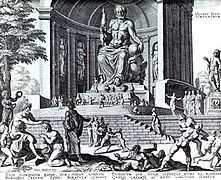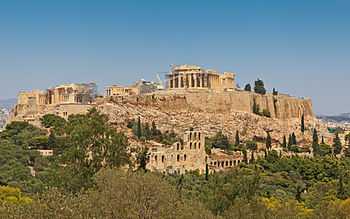Phidias

Phidias or Pheidias (/ˈfɪdiəs/; Greek: Φειδίας, Pheidias; c. 480 – 430 BC) was a Greek sculptor, painter and architect, who lived in the 5th century BC, and is commonly regarded as one of the greatest of all sculptors of Classical Greece:[1] Phidias' Statue of Zeus at Olympia was one of the Seven Wonders of the Ancient World. Phidias designed the statues of the goddess Athena on the Athenian Acropolis, namely the Athena Parthenos inside the Parthenon, and the Athena Promachos, a colossal bronze statue of Athena which stood between it and the Propylaea,[2] a monumental gateway that served as the entrance to the Acropolis in Athens. Phidias was the son of Charmides of Athens.[3] The ancients believed that his masters were Hegias[4] and Hageladas.
Plutarch[5] records that enemies of Pericles, who was a close friend of Phidias, tried to attack Pericles through Phidias who was accused of stealing gold intended for the statue of Athena in the Parthenon and of impiously portraying himself and Pericles on the shield of Athena's statue. The first charge was disproved but Phidias was sent to prison for the second, where he died.[6] Pericles' companion, Aspasia, also accused of impiety and for keeping a disorderly house, was acquitted of the charges against her.[7]

Works


Although no original works exist that can be attributed to Phidias with certainty, numerous Roman copies of varying degrees of fidelity are known to exist. This is not uncommon. Almost all classical Greek paintings and sculptures have been destroyed, and only Roman copies or notes of them exist, like the passages of Plato that ascribe Phidias' works to him. The ancient Romans frequently copied and further developed Greek art.
Ancient critics take a very high view of the merits of Phidias. What they especially praise is the ethos or permanent moral level of his works as compared with those of the later so called "pathetic" school. Demetrius calls his statues sublime, and at the same time precise.
Of his life we know little apart from his works. His first commission created a group of national heroes with Miltiades as a central figure.
In 447 BC, the famous Athenian statesman, Pericles, commissioned several sculptures for Athens from Phidias to celebrate the Greek victory against the Persians at the Battle of Marathon during the Greco-Persian Wars (490 BC). Pericles used some of the money from the maritime League of Delos,[9] to rebuild and decorate Athens to celebrate this victory.
In 1958 archaeologists found the workshop at Olympia where Phidias assembled the gold and ivory Zeus. At the site, there were still some shards of ivory as well as moulds and other casting equipment, and a black glaze drinking cup[10] engraved "I belong to Phidias".[11]
The Golden Ratio has been represented by the Greek letter  (phi), after Phidias, who is said to have employed it. The Golden Ratio is an irrational number approximating 1.6180[12] which has special mathematical properties. The golden spiral is also said to hold aesthetic values.
(phi), after Phidias, who is said to have employed it. The Golden Ratio is an irrational number approximating 1.6180[12] which has special mathematical properties. The golden spiral is also said to hold aesthetic values.
Early works
The earliest of the works of Phidias were dedications in memory of Marathon, celebrating the Greek victory. At Delphi he created a great group in bronze including the figures of Greek gods Apollo and Athena, several Attic heroes, and General Miltiades the Younger. On the Acropolis of Athens Phidias constructed a colossal bronze statue of Athena, the Athena Promachos, which was visible far out at sea. Athena was the goddess of wisdom and warriors and the protector of Athens. At Pellene in Achaea, and at Plataea Phidias made two other statues of Athena, as well as a statue of the goddess Aphrodite in ivory and gold for the people of Elis.
Zeus at Olympia and the Athena Parthenos
For the ancient Greeks, two works of Phidias far outshone all others, the colossal chryselephantine figures of Zeus (c. 432 BC) which was erected in the temple of Zeus,[13] at Olympia, Greece, and the Athena Parthenos (literally, "Athena the Virgin"), a sculpture of the Greek virgin goddess Athena named after an epithet for the goddess herself, which was housed in the Parthenon in Athens. Both sculptures belong to about the middle of the 5th century BC. A number of replicas and works inspired by it, both ancient and modern, have been made. From the late 5th century BC, small copies of the statue of Zeus found on coins from Elis, which give a general notion of the pose and the character of the head. The god was seated on a throne, every part of which was used for sculptural decoration. His body was of ivory, his robe of gold. His head was of somewhat archaic type: the bust of Zeus found at Otricoli, which used to be regarded as a copy of the head of the Olympian statue, is certainly more than a century later in style.
Materials and theories
In antiquity Phidias was celebrated for his statues in bronze and his chryselephantine works (statues made of gold and ivory). In the Hippias Major, Plato claims that Phidias seldom, if ever, executed works in marble, though many of the sculptures of his times were executed in marble. Plutarch tells us that he superintended the great works ordered by Pericles on the Acropolis.
Inscriptions prove that the marble blocks intended for the pedimental statues of the Parthenon were not brought to Athens until 434 BC, which was probably after the death of Phidias. It is therefore possible that most of sculptural decoration of the Parthenon was the work of Phidias' workshop including pupils of Phidias, such as Alcamenes and Agoracritus.
Our actual knowledge of the works of Phidias is very small. There are many stately figures in Roman and other museums which clearly belong to the same school as the Parthenos. These are copies from the Roman age.
According to geographer Pausanias (1.28.2), the original bronze Lemnian Athena was created by Phidias (c. 450-440 BC) for Athenians living on Lemnos. Adolf Furtwängler suggested that he found a copy of Phidias's Lemnian Athena in a statue of which the head is located in Bologna and the body is at Dresden. Some 5th century BC torsos of Athena have been found at Athens. The torso of Athena in the École des Beaux-Arts at Paris, which has unfortunately lost its head, gives some idea of what the original statue may have looked like.
Phidias' workshop rediscovered

A significant advancement in the knowledge of Phidias' working methodology came during 1954–1958 with the excavation of the workshop at Olympia where Phidias created the Statue of Zeus at Olympia. Tools, terracotta molds and a cup inscribed "I belong to Phidias" were found here, just where the traveller Pausanias said the statue was constructed.[14][15][16] The discovery has enabled archaeologists to re-create the techniques used to make the statue and confirm its date.
Gallery
-

Head of Aphrodite. Phidian style
-

Zeus in Olympia, representation on coin
-

Reconstruction of Athena Lemnia, Dresden
-
Head of Athena, Roman copy
-

Wounded Amazon - Musei Capitolini, Rome
See also
- 4753 Phidias, a main-belt asteroid named after Phidias.
- Constantinople - destruction in 1204 of the great statue of Athena, the work of Phidias
References and sources
- References
- ↑ Phidias
- ↑ Birte Lundgreen, "A Methodological Enquiry: The Great Bronze Athena by Phidias" The Journal of Hellenic Studies
- ↑ Not the Charmides who participated in the tyranny at Athens.
- ↑ Not to be confused with Hegias the neoplatonic philosopher.
- ↑ Plutarch. Life of Pericles, 31.
- ↑ Woodford, Susan. (1982) The Art of Greece and Rome. Cambridge: Cambridge University Press, p. 52. ISBN 0521298733
- ↑ Bertrand Russell, The History of Western Philosophy, Chapter 10, Protagoras, page 95
- ↑ "Replica of The Hémicycle". The Walters Art Museum.
- ↑ The Delian team was an association of approximately 150 Greek city-states under the leadership of Athens, whose purpose was to continue fighting the Persian Empire.
- ↑ Image of the cup
- ↑ The Oxford Art Dictionary, s.v. "Phidias"
- ↑ The golden ratio can be derived by the quadratic formula, by starting with the first number as 1, then solving for 2nd number x, where the ratios (x + 1)/x = x/1 or (multiplying by x) yields: x + 1 = x2, or thus a quadratic equation: x2 − x − 1 = 0. Then, by the quadratic formula, for positive x = (−b + √(b2 − 4ac))/(2a) with a = 1, b = −1, c = −1, the solution for x is: (−(−1) + √((−1)2 − 4·1·(−1)))/(2·1) or (1 + √(5))/2.
- ↑ Statue of Zeus from encyclopædiabritannica.com. Retrieved 22 November 2006.
- ↑ "Phidias", Oxford Dictionary of Art, e-Notes.com
- ↑ K. Kris Hirst, "A Walking Tour of Olympia, Greece," about.com
- ↑ "Olympia, Workshop of Pheidias," Perseus Building Catalog, about.com
- Sources
 This article incorporates text from a publication now in the public domain: Chisholm, Hugh, ed. (1911). Encyclopædia Britannica (11th ed.). Cambridge University Press.
This article incorporates text from a publication now in the public domain: Chisholm, Hugh, ed. (1911). Encyclopædia Britannica (11th ed.). Cambridge University Press.- Andrew Stewart, One Hundred Greek Sculptors: Their Careers and Extant Works, Part III of Stewart's Greek Sculpture, (Yale University Press) (on-line text at Perseus).
- Pía Figueroa, "on Phideas," (PDF file) English translation with references
External links
-
 Media related to Phidias at Wikimedia Commons
Media related to Phidias at Wikimedia Commons - Phidias as a First Name in USA


